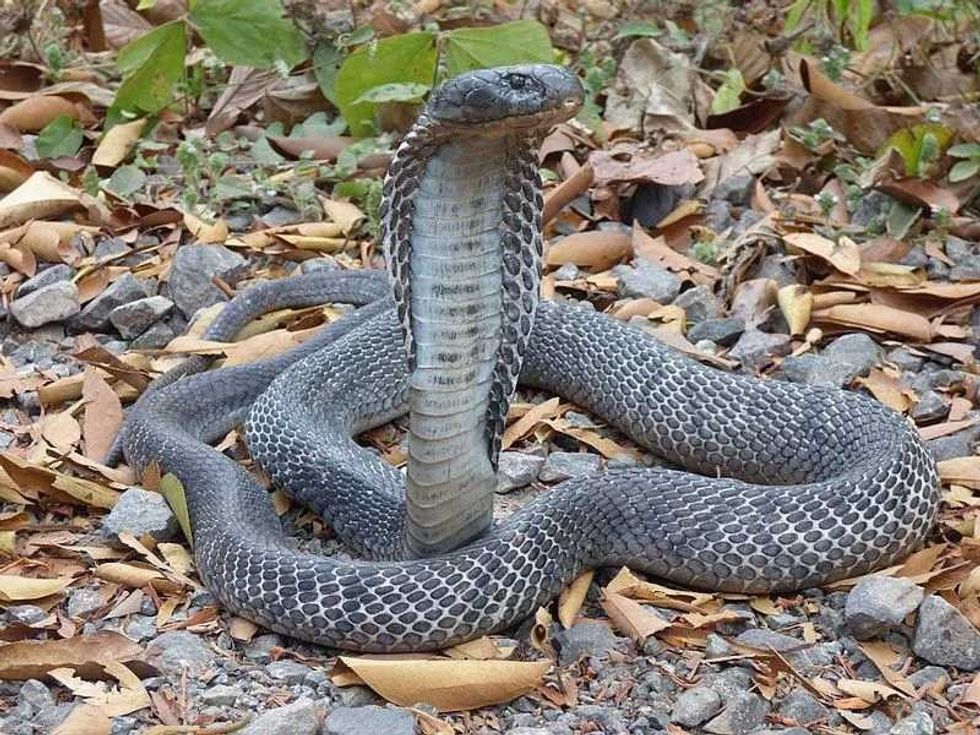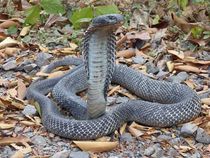The Andaman cobra (Naja sagittifera), also known as Andaman spitting cobra, is a cobra species endemic to the Andaman and little Islands of India. This snake is venomous and can also spit venom, although not as well as other Asian spitting cobra.
The adult snake comes in three color patterns: first is the uniform glossy black above and glossy dark gray above with a blackhead and patches of pale white on shields. Secondly, pale brown or cream color above, with faint black lines around the body and tail with a brownish tint.
Distinct black spots dot the head of this light brown animal. The color is pale brown below the head. The third is a uniform grayish color, and the tail has black narrow patches on the body.
It has series of narrow irregular cross-bars. The head is black in color, with pale white patches on the shields. Juveniles are more glossy and have a dark, distinct black color on top, with narrow, white-colored crossbars running along the body and tail.
The Andaman cobra size is about 9-20 lb (4.1-9.1 kg). It is two times smaller than King Cobra.
If you enjoy reading about the Andaman Cobra, check out interesting facts about the queen snake and anaconda snake.
Andaman Cobra Interesting Facts
What type of animal is an Andaman cobra?
The Andaman cobra (Naja sagittifera) is a cobra species of Elapidae family. Until recently, all Asiatic cobra populations were believed to be of the same species, Naja naja. The number of species of Asiatic Naja has recently been revised to at least ten by Wüster wolfgang.
What class of animal does the Andaman cobra belong to?
The Andaman cobra (Naja sagittifera) is a reptile from genus Naja.
How many Andaman cobra are there in the world?
The exact estimate is not known.
Where does the Andaman cobra live?
The Andaman cobra (Naja sagittifera) species are indigenous to the Andaman and Little Andaman Islands.
What is an Andaman cobra habitat?
The Andaman cobra (Naja sagittifera) is terrestrial species that prefer water during the day. Many individuals have been found near human habitations, particularly in mangrove swamps, thick forests, forest edges, grasslands, and plantations.
Who does the Andaman cobra live with?
Andaman cobra (Naja sagittifera) live on their own in dense or open forests and belong to the family genus Naja. They prey upon small rodents in urban areas with heavy populations. They are also found in hollows in trees, holes in embankments, termite mounds, and rocky landscapes.
How long does an Andaman cobra live?
The longest known lifespan of Andaman cobra (Naja sagittifera) is nine years.
How do they reproduce?
The reproduction in the Andaman cobra (Naja sagittifera) occurs sexually. A female Andaman cobra is an oviparous species, which lays eggs between April and July.
The female cobra guards the eggs throughout the entire incubation period. The Indian cobra lays between 10 - 30 eggs per clutch, the eggs hatch after 48 - 69 days of incubation, and the mother protects the nest with its hood, hissing a few times loudly as the predator runs away.
What is their conservation status?
The Andaman cobra's conservation status is listed as protected in India under the Indian Wildlife Protection Act. The conservation status of the Andaman cobra is currently Not Listed by IUCN. Its main deadly threats are humans and predators.
Andaman Cobra Fun Facts
What does the Andaman cobra look like?
The Andaman cobra (Naja sagittifera) is a medium to a large snake. It has a heavy body and long cervical ribs capable of expanding to form a hood when threatened.
Throughout its length, the body is compressed posteriorly and sub-cylindrical dorsoventrally. Snakes of this species average about 3 ft (0.9 m) in length, although the longest was found, measuring 5.9 ft (1.8 m).
Adults come in three color patterns: The uniform glossy black above, indistinct monocle hood mark below and glossy dark gray above.
With head black and patches of pale white on shields. Secondly, pale brown or cream color above, with faint black lines around the body and tail, and a dark monocle-shaped mark indistinct in the center, with a brownish tint.
The color is pale brown below the head. Distinct black spots dot the head of this light brown animal.
The third is a uniform grayish color with the body and tail have black series of narrow irregular cross-bars on the body, as well as a black monocle hood mark with a gray center along with a grayish bottom, black-colored head, and pale white patches on shields.
On the throat or underside of the neck of juveniles, a broad black cross-band appears.
Juveniles are glossy, dark black above with narrow, white crossbars on the body and tail that form A shapes when viewed sideways. Its center is black, and it has a distinct white monocle mark.
The monocle mark becomes dark with age, as well as a broad white band underneath it.
The head is black, with some shields being blueish-white. The scalation head is broad and distinct from the neck.
A medium, round pupil, large nostrils, small frontal, no loreal, three postoculars, two or three temporals, one preocular in contact with posterior nasal, two or three postoculars. Scales smooth, seventh longest, elongated, cuneates one on each side, infralabials eight, first four touching the first pair of genitals, ventrals 172–184.

How cute are they?
The Andaman Cobra (Naja sagittifera) is a scary-looking reptile. Rather than finding them cute, most people find them terrifying. They are cute when they raise their hood or are standing still. If you like snakes, you might find them appealing. The glistening of their eyes can be charming to some.
How do they communicate?
Andaman cobra (Naja sagittifera) is usually timid creatures. They are complete loners who enjoy solitude.
Since they are so large, this species usually does not move around much, but they can become very violent and frightening when provoked. Their hiss in a loud and shrill sound similar to the howling of a dog at night.
During the breeding season, the hiss call to find another snake to mate with, in addition to warding off their enemies.
How big is the Andaman cobra?
The average snake length of this species is around 3 ft (0.9 m), but it can get as tall as 4.9 ft (1.5 m), although the longest snake was found measuring 5.9 ft (1.8 m). It is two times smaller than the king cobra.
As in Naja sagittifera, the scalation head is broad and distinct from the neck. A medium, round pupil; large nostrils; small frontal; no loreal; three postoculars; two or three temporals; one preocular in contact with posterior nasal.
Scales smooth, seventh longest, elongated; cuneates one on each side; infralabials eight, first four touching the first pair of genitals; ventrals 172–184, unlike King Cobra. The tail has black narrow irregular cross-bars.
How fast can an Andaman cobra move?
The Andaman cobra (Naja sagittifera) can move up to 12 mph (19.3 kph); they can jump up to 9 ft (274.3 cm). In most cases, it runs slowly, but its hood can be raised to chase humans and other enemies.
How much does an Andaman cobra weigh?
The Andaman cobra (Naja sagittifera) can weigh up to 9-20 lb (4.1-9.1 kg).
What are the male and female names of the species?
There is no specific name for different sex of Andaman cobra (Naja sagittifera). They are generally known as female Andaman cobra and male Andaman cobra.
What would you call a baby Andaman cobra?
A baby Andaman cobra (Naja sagittifera) is called a hatchling.
What do they eat?
Andaman cobra (Naja sagittifera) typically preys on other snakes, mongooses, lizards, chameleons, rodents, and birds. This species begins by lifting their hoods and searching for prey. Because its eyesight is so good, it can find its food even from a distance. To consume their prey, they hunt and swallow their food at once, then become very lazy after eating.
Are they dangerous?
If a human is attacked by an Andaman spitting cobra, the risk of death remains for half a day.
Would they make a good pet?
Keeping cobras as pets at home is not recommended. They are venomous, and the venom is extremely potent. Petting them is not a good idea. There is no sound louder than their hiss.
Did you know...
In India, cobra hoods are equipped with microchips, which are used to track them in the wild and bring them to zoos far from poachers. The venom of these Indian cobras has a small percentage of fatality rate if not treated with proper medication.
King cobras are called so because they kill and eat cobras.
Can Andaman cobra spit?
The venomous composition of Andaman cobra (Naja sagittifera) should be similar to that of Naja kaouthia. Naja kaouthia, a cobra that can inflict both local and flaccid paralysis, usually bites with a painful toothache, sustained swelling, and sometimes blistering or discoloration of the skin.
Over a period of 3-7 days, the skin may become necrotic throughout. Secondary infection, as well as long-term morbidity, are potential outcomes.
Symptoms may develop within a few hours or may take more than 12 hours to appear. For Naja kaouthia, the relative rates of necrosis versus paralysis differ between studies.
A bite from Naja sagittifera is estimated to be lethal in very few patients. Victims of the Caspian cobra bites have a higher lethality rate when left untreated.
How did Andaman cobra get their name?
The Naja sagittifera is classified in the family Elapidae, under the genus Naja. The first European herpetologist and physician to describe it said that it first appeared in 1913. A generic name Naja is derived from the Sanskrit word naga, which is translated as a cobra. Sagittifera is the specific epithet, which is Latin for arrow-bearing.
Cobras of the Caspian region (Naja oxiana) and Monocled region (Naja kaouthia) have been demonstrated to be clades sister to those of Naja sagittifera. Even though the Hindu Kush mountains separate populations, Naja oxiana has one evolutionary lineage, which indicates rapid range expansion during the past. Unlike Naja kaouthia and Naja sagittifera, Naja oxiana does not spit.
Here at Kidadl, we have carefully created lots of interesting family-friendly animal facts for everyone to discover! For more relatable content, check out these cobra and Indian cobra.
You can even occupy yourself at home by coloring in one of our free printable Andaman cobra coloring pages.
Main and second image by Moinudheen.









